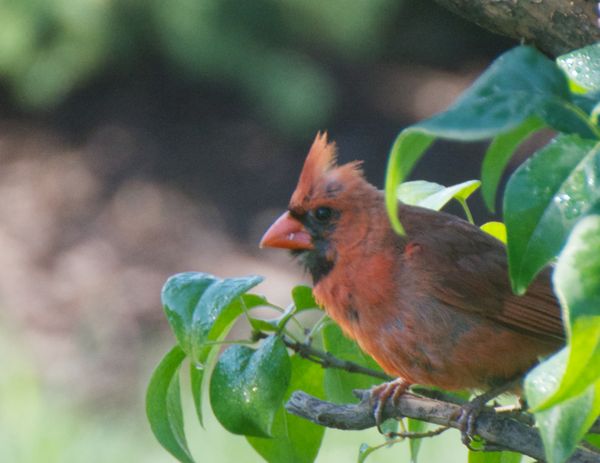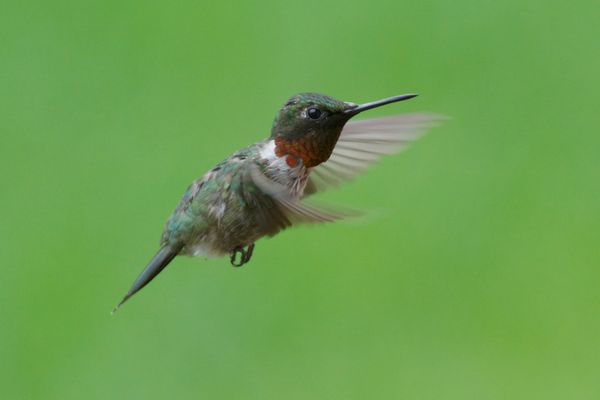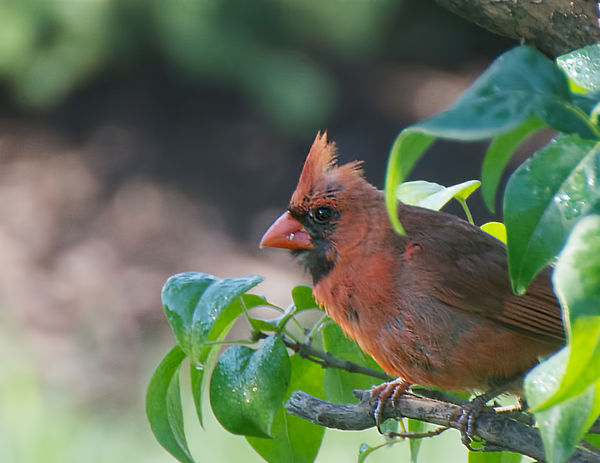Am I on the right track?
Aug 9, 2013 13:46:45 #
I have been practicing with the Nikon D7100, 70-300mm with a 2X converter.
Things I think I have learned
. old hands don't work steady and tripod is a great idea - at the minimum arms should be braced against something
. still need to double the shutter to the length even if the bird is sitting still
. 2X means at least two stops down
. using all this equipment - it will be a while for bif.
How about some feedback for the learning process. I realize some are hot, very early morning sun. I have tweaked some with contrast and levels and a little brightness. I appreciate more learning out of the vacuum.
Thanks for your help
Things I think I have learned
. old hands don't work steady and tripod is a great idea - at the minimum arms should be braced against something
. still need to double the shutter to the length even if the bird is sitting still
. 2X means at least two stops down
. using all this equipment - it will be a while for bif.
How about some feedback for the learning process. I realize some are hot, very early morning sun. I have tweaked some with contrast and levels and a little brightness. I appreciate more learning out of the vacuum.
Thanks for your help



Aug 9, 2013 13:50:37 #
Yes, never ever use a converter unless it is the only way to get a shot
Even the best are carp as far as I am concerned, I would rather have a better/longer lens.
http://digital-photography-school.com/the-pros-and-cons-of-using-tele-converters-extenders-on-your-dslr
I have a top quality 1.4 and that is as far as anyone should really go, and that I will use IF needed, I would rather crop
Even the best are carp as far as I am concerned, I would rather have a better/longer lens.
http://digital-photography-school.com/the-pros-and-cons-of-using-tele-converters-extenders-on-your-dslr
I have a top quality 1.4 and that is as far as anyone should really go, and that I will use IF needed, I would rather crop
Aug 9, 2013 13:53:17 #
Why not use a converter? I am planning a trip to very northern MN in a few weeks. I have taken many animal images and was hoping this would give me a tad more reach without breaking the bank. Is this where you tell me I get what I pay for? :(
Aug 9, 2013 13:55:51 #
lorim222315 wrote:
Why not use a converter? I am planning a trip to very northern MN in a few weeks. I have taken many animal images and was hoping this would give me a tad more reach without breaking the bank. Is this where you tell me I get what I pay for? :(
Read the link I posted
Aug 9, 2013 13:58:31 #
Aug 9, 2013 14:01:43 #
JR1 wrote:
Yes, never ever use a converter unless it is the only way to get a shot
Even the best are carp as far as I am concerned, I would rather have a better/longer lens.
http://digital-photography-school.com/the-pros-and-cons-of-using-tele-converters-extenders-on-your-dslr
I have a top quality 1.4 and that is as far as anyone should really go, and that I will use IF needed, I would rather crop
Even the best are carp as far as I am concerned, I would rather have a better/longer lens.
http://digital-photography-school.com/the-pros-and-cons-of-using-tele-converters-extenders-on-your-dslr
I have a top quality 1.4 and that is as far as anyone should really go, and that I will use IF needed, I would rather crop
Thanks for the link. That did not come through with my first response. I agree with all the cons. Therefore I have to learn to work around the cons as best I can. I have a moose in my sights in northern MN. Just a little more reach and I will be using my tripod. Not an everyday use for sure. Thanks for your comments.
Aug 9, 2013 14:31:56 #
Are you using any software to improve sharpness of your pictures. I tried photoshop for the 1-st picture and it looks much better, IMHO. If you do not mind I can post it.
lorim222315 wrote:
I have been practicing with the Nikon D7100, 70-30... (show quote)
Aug 9, 2013 14:38:46 #
MMC wrote:
Are you using any software to improve sharpness of your pictures. I tried photoshop for the 1-st picture and it looks much better, IMHO. If you do not mind I can post it.
Please post. This is a learning experience. I have PS 9 with 11 sitting in the desk. I have been using Apeture but I did not sharpen only because of a lack of knowledge.
Aug 9, 2013 14:53:08 #
This is my attempt to improve sharpness.
lorim222315 wrote:
Please post. This is a learning experience. I have PS 9 with 11 sitting in the desk. I have been using Apeture but I did not sharpen only because of a lack of knowledge.

Aug 9, 2013 16:31:29 #
lorim222315 wrote:
I have been practicing with the Nikon D7100, 70-30... (show quote)
Feedback...... First; I take it from your post that you are relatively inexperienced? if so.....you like to take photos of birds? So do I! I love birds; but birds are usually very difficult subjects; they're mostly quite small, they usually never sit still for long, etc. If you look at the work of some of the top wildlife professionals, then read any of their books, you'll note that they ALL say the same thing........"know your subject".......which simply means, to photograph birds for example, you must be keenly aware of the particular bird's habits that you are attempting to photograph. Every different species of birds have different habits; the more you learn about those habits, the more chance you have of getting great pictures of them.
Hummingbirds? Their habits are quite different from most birds; they are so small, they move so fast, etc. that what works for, say cardinals, won't work for hummers; two things about hummers; they are always drawn to feeders; in addition, because they expend so much energy, they like to perch near enough to their their favorite feeder to see it, because they are VERY "territorial"; with careful observation, you can sometimes notice where they like to perch; a sharp photo of a hummer perched on a small twig is usually much better than a much less sharp photo of the same bird hovering; also, a hummer "in hover" at an attractive flower is always better that one at a feeder; many of the really good photos of humming birds are taken with the camera on a tripod, pre-focused, pre-set, and the shutter tripped with a wireless remote. (And take a lot of time and effort to make.) Tough subject......better to learn on the easy stuff.
I'm not saying that beginners shouldn't try to photograph hummingbirds; I am pointing out that hummers are very difficult subjects, even for those who know a lot about their habits; for those who don't ? Better have a flash unit with a very short "duration" and really learn how to use it! (All of those photos of hummers you see in "Birds & Blooms" magazine with their wings razor sharp were made with very fast electronic flash units.)
Of all the tricks that pro's use to get great bird pictures, the most common is to photograph them when they are nesting;
again, some birds, such as cardinals, like to nest near the ground in rose bushes and evergreens; robins tend to nest "all over", (such as on my front porch light, right beside the front door;) Purple martins only nest in well made martin "houses", whole other birds, such as herons, only nest in very tall trees in "rookeries" (with other herons). The best subjects ? Mountains ! they usually "stay put", and can be photographed from 10 miles away, or 10 feet away!
BTW......from looking at your humming birds.......You're definitely learning fast! The cardinal ? May not quite make it to "Birds & Blooms", but still a VERY nice shot! another "tip"; don't always depend on the camera's autofocus; learn to shoot in manual mode, and above all, learn to focus sharply with "live view"; to do that effectively, you need some magnification; (like about 3X) I tried a Hoodman loupe, but it left a lot to be desired; I'm now using a Zacuto "Z finder" which is MUCH better, but NOT cheap. Many of the razor sharp bird photos you see were made with very careful manual focus, mirror locked up, and camera on tripod and triggered by wireless remote. (and a fast shutter speed!)
BTW......(again)....If you ever get the urge to photograph foxes....forget about it! They're ever harder than birds! (The one on my avatar is about all I have to show from about 5 years or so of effort, and any photo editor would turn it down in 2 seconds!)
Aug 9, 2013 16:56:06 #
JR1 wrote:
Read the link I posted
Read the link ....
I have a Sigma 2x extender
Will agree on the slow focus..Fact
Will agree on the light..........Fact
If I use on my F2.8 (becomes F5.6) and raise upto f8 or f11 the images are superb.... Fact
The important message... they are not a waste of time if you know how to use and get the best out of them by experimenting with them using various settings. Keep away from the extremes of the lens aperture and you will be okay..
although someone who took it to a tennis match once according to the article and decided it doesn't work must be right... :lol: :lol: ;)
:thumbup:
Aug 9, 2013 17:11:34 #
JoboX wrote:
Read the link .... br br I have a Sigma 2x extend... (show quote)
Very well said JoboX ! I was wondering when someone would finally put that notion to rest. If TC's were "useless", big camera companies and lens manufacturers wouldn't be making the things. Saying a 2X TC is "useless" is about like trying to hand-hold a 600mm/f4 lens, while shooting at 1/50 in poor light, then getting a "useless" image! (Sorry Vern, but you don't know what you're doing!)
Aug 9, 2013 22:25:39 #
MMC wrote:
This is my attempt to improve sharpness.
Thank you for work on the sharpness correction. This does look great. I will start playing with making some images more sharp.
Aug 9, 2013 22:50:57 #
Gitzo UH wrote:
Feedback...... First; I take it from your post th... (show quote)
Thank you so much for your feedback.
I am not ready to throw out the new TC. I am just stubborn enough to keep at it. I agree with all the cons, however that does not mean I can't get a great image with it. I have had it for two days. I am guessing it might take two months.
I have a setup here that might make some of my neighbors think I am a very strange old lady. Tripods, windows open, old lady hanging out, cameras sticking out of windows and a glass of wine somewhere near by, with assurances to the neighbors they are not the subjects.
I have to try out new things with what critters I have around me. 15 bird feeders and critter crunch have been the standard here for years and years. Country living. I may never be published, but I have won a few awards. But tack sharp focus is always the prize.
Here is my fox. He was not shy.

Aug 10, 2013 12:40:42 #
Yes they could be sharper. Great shots anyway. I suffer from being 66 years old, shaky and don't see so good. :-)
Try not to compare your shots to the ones taken with a $3000.00 lens.
The hummingbird in flight is beautiful. Keep shooting. :thumbup:
Try not to compare your shots to the ones taken with a $3000.00 lens.
The hummingbird in flight is beautiful. Keep shooting. :thumbup:
If you want to reply, then register here. Registration is free and your account is created instantly, so you can post right away.






